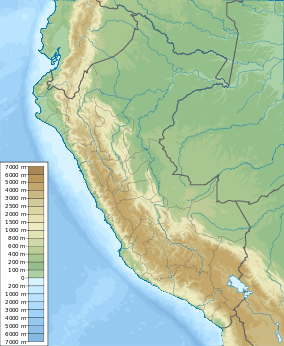Paryaqaqa
From Wikipedia, the free encyclopedia
| Paryaqaqa | |
|---|---|
| Tulluqutu | |
 The southern and the northern peak of Paryaqaqa | |
| Elevation | 5,750 m (18,865 ft)[1] |
| Location | |
 Paryaqaqa | |
| Location | Peru, Lima Region, Junín Region |
| Range | Andes, Paryaqaqa mountain range |
| Coordinates | 11°59′30″S 75°59′30″W / 11.99167°S 75.99167°WCoordinates: 11°59′30″S 75°59′30″W / 11.99167°S 75.99167°W |
| Climbing | |
| First ascent |
1938, Paryaqaqa S, T. Dodge 1936, Paryaqaqa N, T. Dodge[2] |
Paryaqaqa (Quechua parya reddish, sparrow, qaqa rock,[3][4] Paryaqaqa or Parya Qaqa, a regional deity, a mountain god,[5] hispanicized spellings Pariacaca, Pariacacca, Pariaccaca, Pariaccacca, Pariakaka, Paria Caca) or Tulluqutu (Quechua tullu bone, qutu heap, "bone heap", hispanicized Tullujuto)[6] is the highest mountain in the Paryaqaqa mountain range (or Waruchiri mountain range) in the Andes of Peru, about 5,750 metres (18,865 ft) high. It is situated on the border of the Junín Region and the Lima Region.
See also
References
- ↑ allthemountains.com Map of a part of the Paryaqaqa mountain range
- ↑ montanasperuanas.com Pariacaca 5750 m, "El Gran Apu"
- ↑ César W. Astuhuamán Gonzáles, Pariacaca: un oráculo imperial andino: "Respecto al significado del nombre de la deidad, los términos Paria (rojiza) y caca (montaña), aluden a una montaña rojiza, ... ."
- ↑ Teofilo Laime Ajacopa, Diccionario Bilingüe Iskay simipi yuyayk'ancha, La Paz, 2007 (Quechua-Spanish dictionary): parya, Phichitanka. - s. Gorrión. Pájaro de plumaje castaño. qaqa. - s. Peña. Piedra grande sin labrar, peñasco. || Roca. Piedra muy dura.
- ↑ Steven Kaplan, Indigenous Responses to Western Christianity, New York and London, 1995, p. 68-69
- ↑ Evelio Echevarría, The Cordillera Huarochiri, Peru, The Alpine Journal 2001
External links
| Wikimedia Commons has media related to Paryaqaqa. |
This article is issued from Wikipedia. The text is available under the Creative Commons Attribution/Share Alike; additional terms may apply for the media files.